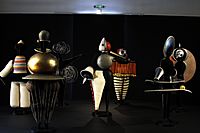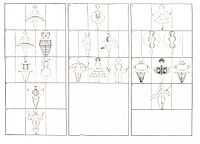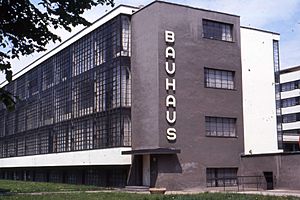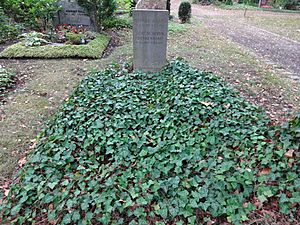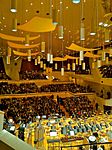Lou Scheper-Berkenkamp facts for kids
Quick facts for kids
Lou Scheper-Berkenkamp
|
|
|---|---|
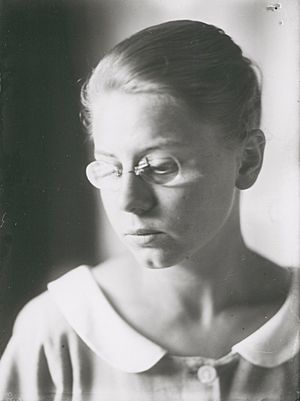 |
|
| Born |
Hermine Luise Berkenkamp
May 15, 1901 Wesel, Germany
|
| Died | April 11, 1976 |
| Resting place | Waldfriedhof Zehlendorf |
| Spouse(s) | Hinnerk Scheper |
Lou Scheper-Berkenkamp (born Hermine Luise Berkenkamp; May 15, 1901 – April 11, 1976) was a talented German artist. She was a painter, a designer who worked with colors, and a writer and illustrator of children's books. She also designed costumes for plays. Lou was known for her modern and unique artistic style.
Contents
Early Life and Discovering Art
Lou Scheper-Berkenkamp was born in Wesel, Germany. Her father, Adalbert Berkenkamp, and her uncle managed a paper factory. Lou had two brothers, Alfred and Walter.
She went to elementary school and then a grammar school. Later, she attended the Viktoria-Schule in Essen, a special girls' school with new teaching methods. Her art teacher, Margarete Schall, noticed Lou's amazing talent for colors and painting. Even though Lou first wanted to study medicine or German, Margarete suggested she go to art school. This school was known for its modern teaching.
Her school report from 1920 said she had a "marked talent for literary and artistic problems." It also praised her "very good performance in German and in drawing." These skills shaped her whole life.
The Bauhaus Years
In 1920, after finishing high school, Lou Berkenkamp joined the Bauhaus art school in Weimar. This was a very famous and modern art school. She learned from famous artists like Johannes Itten, Lyonel Feininger, Paul Klee, and Georg Muche.
At Bauhaus, she met Hinnerk Scheper, who was also studying mural painting. They got married on December 24, 1922. Lou lived with her parents in Wesel for a few years. Their son, Jan Gisbert, was born in 1923. During this time, Lou started creating her first "picture letters," which were like illustrated stories.
In 1922, Lou and Hinnerk left Bauhaus Weimar. Lou focused on her art, while Hinnerk became a color designer. In 1925, Hinnerk was invited back to Bauhaus, which had moved to Dessau. He became a master in the mural painting workshop. Their daughter, Britta, was born in Dessau in 1926.
Lou Scheper-Berkenkamp also worked in the stage workshop at Bauhaus Dessau. She helped Oskar Schlemmer create costumes, dances, and sets for his famous "Triadisches Ballett" (Triadic Ballet). This ballet had its first show in 1922. She also designed costumes and sets for other plays. In 1928, she showed her work in an exhibition called "Young Bauhaus Painter." She also created several children's books during this time. The Scheper family stayed connected to Bauhaus until it closed in 1933.
Life in Moscow (1929-1931)
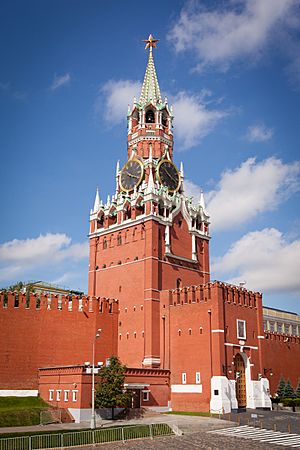
From 1929 to 1930, the Schepers moved to Moscow. Hinnerk was asked to set up a special center for color design in buildings and cities for the entire Soviet Union. Lou worked with him on these color plans.
While in Moscow, Lou also wrote articles for a German newspaper called "Moskauer Rundschau." She wrote about daily life in the big city, showing her artistic and thoughtful view. She also created abstract collages using basic shapes like circles, triangles, and squares. These were inspired by the figures from the Triadic Ballet. She also painted Moscow's street life with ink and colors, creating clever pictures and texts.
During National Socialism
After another short visit to Moscow in 1931, the Schepers returned to the Bauhaus in Dessau. The school was now led by Ludwig Mies van der Rohe. When Bauhaus moved to Berlin in 1932, they moved too.
The political situation in Germany became very difficult. The Nazi party gained power, and they did not like the modern art and ideas of the Bauhaus. In 1932, the city council in Dessau cut all funding for Bauhaus. The school was forced to close on October 1, 1932. The building was then used by the Nazi Party.
Mies van der Rohe tried to keep Bauhaus going in Berlin with his own money. But the Nazis forced him to close it completely on July 20, 1933. Many Bauhaus artists had to find other jobs or leave Germany.
Lou Scheper-Berkenkamp became a freelance painter in Berlin. Between 1933 and 1945, she designed many children's books. Some of these were published after World War II. Her son Dirk was born in Berlin in 1938. Lou also helped Hinnerk with his photography trips, writing texts for his landscape pictures.
The Nazis made it hard for Hinnerk to work, so the family focused on designing colors for public buildings, murals, and restoration work. Hinnerk served in the military from 1942 to 1945. During this time, Lou took care of the family by herself. She created picture stories, which were later published as children's books. The family lived quietly during the war.
After World War II
After the war ended in 1945, Lou Scheper-Berkenkamp and her children, Britta, Jan Giesbert, and Dirk, were in Badbergen. Her parents, whose house in Wesel was destroyed, were also with them.
In Berlin, Hinnerk Scheper was appointed to help preserve historical buildings. Lou supported him in his work. She also started focusing on her art again and looked for a way to publish her children's books. She found a great publisher in Leipzig, Ernst Wunderlich, who had good printing methods.
One person said about her books: "These picture books are bursting with life and movement... written by a 'poet painter' who created a unity from text and image."
In 1950 and 1951, Lou's original picture book drawings were shown in exhibitions. Her works were displayed in "America Houses" in several German cities. These "America Houses" were set up by the Allies after the war to promote democratic ideas. In these friendly places, Lou's timeless and artistic stories could be shared.
"The Ring" Artists' Association and New Projects
In 1951, Lou Scheper-Berkenkamp helped start a group of artists in Berlin called "The Ring." She was on the board until 1970. She exhibited her art with other members in the "Haus am Waldsee" in Berlin-Zehlendorf.
Lou also took part in many exhibitions in West Germany and sometimes abroad. She was very active in the "Professional association of visual artists" in Berlin until 1970. From 1956 to 1969, she helped organize the yearly "Great Berlin Art Exhibition."
After Hinnerk Scheper passed away in 1957, Lou took over his work in color design for buildings in Berlin. She helped choose colors for the inside of many important buildings. These included a children's home designed by Otto Bartning, the Berlin Philharmonic Hall by Hans Scharoun, the Egyptian Museum of Berlin, and various buildings by Walter Gropius. She also worked on the color plans for the Berlin Tegel Airport building.
Lou Scheper-Berkenkamp continued working on color concepts for the Berlin State Library until she passed away on April 11, 1976.
Lou Scheper-Berkenkamp died in West Berlin, which was a city surrounded by East Germany at the time. She is buried with her husband in the Zehlendorf cemetery.
Works
The Scheper Family
On December 22, 1922, Lou married Hinnerk Scheper in Weimar. They had three children:
- Jan Gisbert (born November 7, 1923)
- Britta (born March 28, 1926; died January 14, 2012)
- Dirk (born August 21, 1938)
Dirk's wife, Renate Scheper, became her daughter-in-law.
Published Picture Books
Lou Scheper-Berkenkamp wrote and illustrated several children's books:
- Knirps, ein ganz kleines Ding (1948)
- Doll Lenchen (1948)
- Tönnchen, Knöpfchen und andere (1948)
- The stories of Jan and Jon and of their pilot fish (1948)
Unpublished Children's Book Manuscripts
She also created many children's book ideas that were not published during her lifetime, including:
- Bälkchen erzählt seine Geschichte (1948)
- Die ernsthafte Geschichte von den vertriebenen und wieder versöhnten Gestirnen (1948)
- The blotter children and their dog (announced in 1948)
- Blümchens Abenteuer, eine wunderliche Geschichte (announced in 1948)
- The Vain Little Girl Story (around 1949)
- Sonderbare Reise eines kleinen Mädchens namens Tüttchen und eines namenlosen aber goldenen Kirchturmhahnes (around 1949)
- Carnival (around 1949)
- The story of a child's last dream (around 1949)
See also
 In Spanish: Lou Scheper-Berkenkamp para niños
In Spanish: Lou Scheper-Berkenkamp para niños



